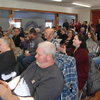Capital project debated again at BKW board of ed
BERNE — Following a presentation looking further into what could be completed in the Berne-Knox-Westerlo School District’s capital project, the school board debated the overall cost and financing, with one member firmly against the current price tag and several others stating the costs would be worthwhile in improving school facilities.
Jim Graham of Synthesis Architects gave a presentation on the project at Thursday’s meeting, mostly going over what site work would be needed and the estimated cost, which totaled $14.6 million after adding on $1.5 million in site work.
Superintendent Timothy Mundell went over the funding for the project: there is already $1.65 million in the capital reserve fund; the school can fund up to $2 million as a cap; and the school’s fund balance last year had some funding.
“We’re hoping to go into this project with about $2 million of local money,” he said, bringing the cost of the project down to $12.6 million. The school would pay for this with a bond payment over 15 years; about $780,000 each year.
Mundell also noted that about 80 percent of the project would be covered by the state. He referenced a community survey in which a majority said they would be willing to pay $75 a year for improvements to the school.
The site work involved changing the makeup of parking on the two adjacent campuses — one for the elementary school and one the other for the secondary school. Visitor parking would be moved to a front lot separated from school-bus parking by a strip of sidewalk. Graham also suggested sidewalks along much of the school in place of current parking spots, which he said threatened school safety. Plans also include an outdoor-classroom area in the elementary-school courtyard.
The estimated cost includes:
— $6.3 million for infrastructure repairs in the elementary school;
— $935,000 in security improvements at the elementary school;
— $4.1 million in educational programming at the elementary school;
— $700,000 for infrastructure repairs at the secondary school;
— $620,000 for security improvements at the secondary school;
— $320,000 for educational programming at the secondary school;
— and $160,000 for work on the school bus garage.
Board member Lillian Sisson-Chrysler expressed concern over the cost. She had stated at previous meetings that she would settle for a maximum of $13 million to go to the project, and at Thursday's meeting said she would hold firm on that.
“I feel we need to shave something, but I don’t know where yet,” she said.
She later suggested cutting improvements for the elementary-school cafeteria for the project scope, stating that there were other rooms to hold meetings in. Synthesis had suggested in past presentations improving the acoustics of the cafeteria and equipping it to be used as a community meeting space during off hours.
School business manager Sarah Blood countered by noting how much money is spent to heat and light the secondary school auditorium, where the meeting was held that night. Graham also noted that the cafeteria improvements were not significant to the overall cost of the budget, but could be taken out.
Sisson-Chrysler expressed concern over whether the project would be voted down by residents concerned over the cost. Board member Kim Lovell responded that it could also be voted down if too much is taken away.
Blood said that the bond payment was necessary as a whole for the district’s economic health. BKW is going to have a separate bond payment paid off soon, and putting debt back on balances the budget. Mundell explained that it is calculated into the tax cap.
Board President Matthew Tedeschi stated that the school was preparing a “21st Century education” for the students.
“Our building is currently hindering that education,” he said. Tedeschi noted the declining enrollment in the school, which the board had reviewed at its last workshop, and said that improving the school could bring in students.
“So your thought is, ‘We’ll build it and they’ll come?’” asked Sisson-Chrysler.
“No, there’s multiple pieces to that,” replied Tedeschi, listing off points of pride for the school such as the expanding agricultural science program and increasing test scores, and concluding that improved facilities would be part of that.
Sisson-Chrysler asked Graham for more details on each of the proposed improvements. Graham responded that, until a scope was developed, that wouldn’t be feasible. He later said he could return with a budget that broke down each estimated cost by the various proposed projects and repairs.
Mundell also asked Graham if the firm could ensure the project could be carried out at its proposed cost over the time it would take complete it. Graham said they would be able to do that.
Later, the superintendent presented a survey of elementary school teachers, which had a majority responding favorably towards improving the facilities.

